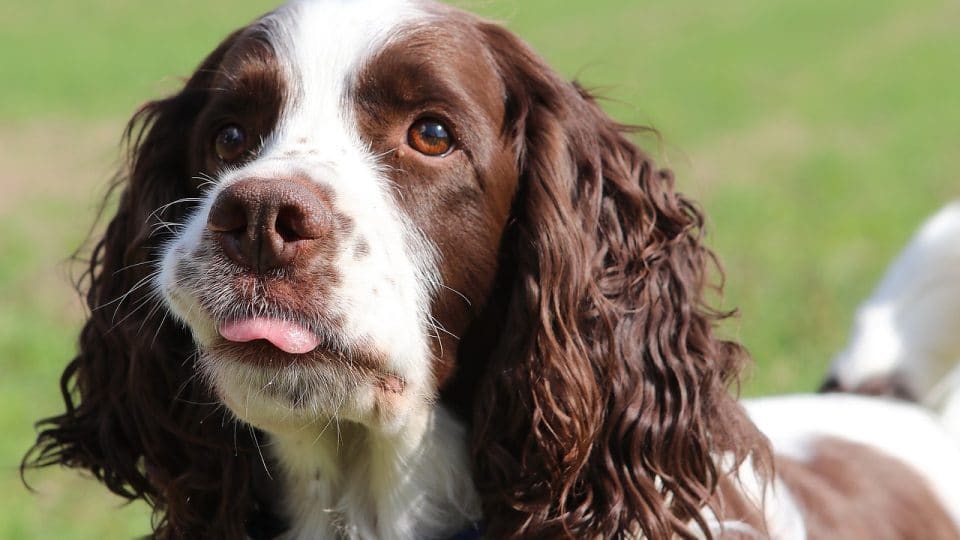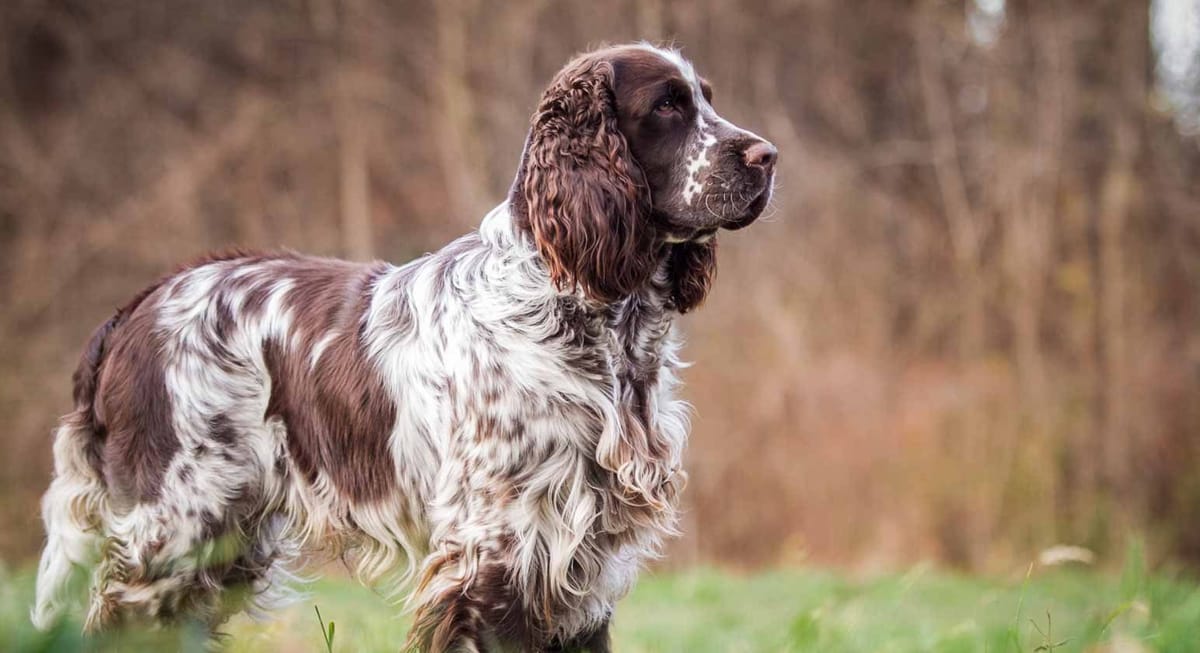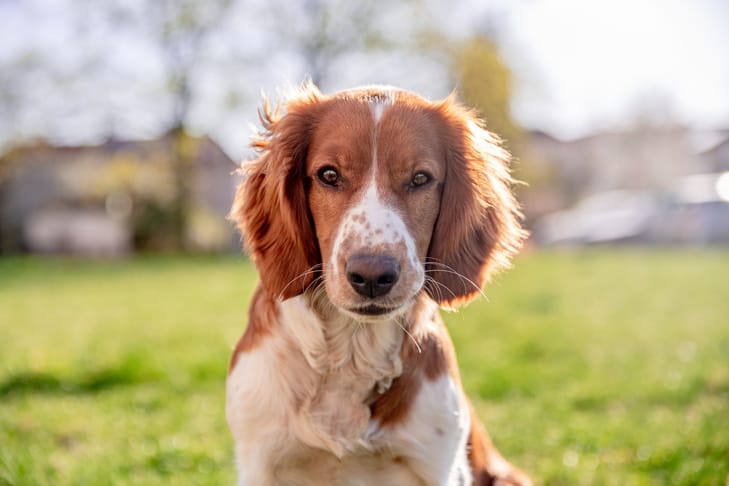English Springer Spaniels enchant dog lovers with their charming demeanor and playful nature. As a dedicated owner, it is crucial to comprehend the developmental phases of your Springer Spaniel to guarantee optimal growth and fulfillment of their potential. This segment delves into the distinct growth stages that your English Springer Spaniel will traverse.
Puppyhood: The Early Growth Stage
During the first few weeks of life, English Springer Spaniel puppies grow rapidly. They rely on their mother's milk for nutrition and start to open their eyes and ears. Around 3 to 4 weeks, puppies begin to walk and explore their surroundings. At this stage, their growth mainly involves building muscle, developing coordination, and strengthening their bones.
Between 4 to 6 months, puppies experience a growth spurt, both physically and mentally. Their bodies start to fill out, and they may appear a bit uncoordinated as they adjust to their rapidly changing size. It's crucial to provide them with a balanced diet that supports their growth and provides them with the necessary nutrients.
Adolescence: The Growth Continues
As your English Springer Spaniel enters adolescence, around 6 to 12 months, their growth rate starts to slow down. However, they are still developing and maturing. During this stage, your Springer Spaniel may experience changes in behavior, such as increased energy levels or a stubborn streak. This is completely normal and part of their development process.
The growth plates in their bones begin to close during adolescence, which signifies the end of their height growth. However, their bodies continue to fill out and gain muscle mass. It's essential to provide them with regular exercise and a well-balanced diet to support their ongoing development.
Adulthood: Reaching Full Size
On average, English Springer Spaniels reach their full height and size when they are around 1 to 2 years old. By this time, their growth plates have completely closed, and they have attained their adult height. However, keep in mind that individual dogs may have slight variations in their growth patterns, so it's important to consider your specific dog's genetics and overall health.
Once your Springer Spaniel reaches adulthood, their focus shifts from growth to maintaining their overall health and well-being. It's crucial to continue providing them with a nutritious diet, regular exercise, and mental stimulation to keep them happy and healthy throughout their adult years.
When Do English Springer Spaniels Reach Their Full Height?
One common question among English Springer Spaniel owners is, "When do they reach their full height?" While the growth process varies from dog to dog, there are general timelines to keep in mind. In this section, we'll explore when you can expect your English Springer Spaniel to reach their full height.
Factors Affecting Height Growth:
Various factors can influence the height growth of English Springer Spaniels. Genetics play a significant role, as taller parents are more likely to produce taller offspring. Other factors include nutrition, exercise, and overall health. Proper nutrition and a balanced diet are crucial during the growth stages to ensure your Springer Spaniel reaches their full height potential.
Average Height Range:
On average, male English Springer Spaniels stand between 19 to 20 inches tall at the shoulder, while females are slightly smaller, ranging from 18 to 19 inches. However, it's important to note that individual dogs may fall outside of these ranges due to genetic variations.
Most English Springer Spaniels experience their height growth spurts between 4 to 6 months, with gradual growth continuing until they reach their full height around 1 to 2 years of age. Keep in mind that monitoring your dog's growth is essential, and if you have any concerns, consult with your veterinarian.
Monitoring Growth:
To monitor your English Springer Spaniel's growth, you can measure their height from the ground to the highest point of their shoulder blades regularly. This can give you an idea of their growth progress and help identify any potential growth issues or abnormalities.
Remember, it's important to consider your English Springer Spaniel's overall health, genetics, and individual variation when determining their growth timeline. Consulting with your veterinarian can provide you with personalized advice and ensure your dog is on track for healthy growth.
When Do English Springer Spaniels Reach Their Full Weight?
In addition to height, weight is another important factor in determining when English Springer Spaniels reach their full size. In this section, we'll explore the typical weight range for English Springer Spaniels and when you can expect them to reach their full weight.
Factors Affecting Weight Growth:
Similar to height growth, various factors can influence the weight development of English Springer Spaniels. Genetics, nutrition, exercise, and overall health all play a role in your dog's weight. Providing a balanced diet and ensuring they receive regular exercise is crucial for healthy weight development.
Average Weight Range:
On average, male English Springer Spaniels weigh between 50 to 55 pounds, while females weigh slightly less, ranging from 40 to 50 pounds. However, individual dogs may fall outside of these ranges due to genetic variations and overall health.
During the growth stages, English Springer Spaniels typically gain weight rapidly, with most of the weight gain occurring between 4 to 6 months. However, it's important to note that each dog is unique, and growth rates can vary. By around 1 to 2 years of age, most English Springer Spaniels reach their full weight.
Monitoring Weight:
Monitoring your English Springer Spaniel's weight is essential to ensure they are growing at a healthy rate. Regularly weigh your dog and keep track of their progress. If you notice any significant deviations from the expected weight range or sudden weight loss or gain, consult with your veterinarian for guidance.
Remember, maintaining a healthy weight is crucial for your English Springer Spaniel's overall well-being and longevity. Regular exercise, portion control, and a balanced diet will help them maintain a healthy weight throughout their life.
Factors That Can Influence the Growth of English Springer Spaniels
While there are general timelines for when English Springer Spaniels stop growing, it's important to understand that several factors can influence their growth. In this section, we'll explore some of the key factors that can impact the growth of English Springer Spaniels.
Genetics:
Genetics plays a significant role in determining the growth patterns of English Springer Spaniels. The genes inherited from their parents can influence their height, weight, and overall body structure. If both parents are tall and have a larger build, likely, their offspring will also be bigger.
Nutrition:
Proper nutrition is essential for healthy growth in English Springer Spaniels. Providing a well-balanced diet that includes high-quality protein, vitamins, and minerals is crucial during the growth stages. Consult with your veterinarian to determine the appropriate diet for your Springer Spaniel based on their specific needs and growth requirements.
Exercise:
Regular exercise is important for the overall development and growth of English Springer Spaniels. Engaging in activities that promote muscle development and coordination can contribute to their growth. However, it's important to avoid excessive exercise during the growth stages, as this can put a strain on their developing joints. Consult with your veterinarian to determine the appropriate exercise routine for your dog.
Health:
The overall health of your English Springer Spaniel can impact their growth. Health issues, such as nutritional deficiencies or underlying medical conditions, can hinder their growth potential. Regular veterinary check-ups, vaccinations, and preventive care can help ensure your dog's health is optimized for proper growth.
Environmental Factors:
Environmental factors, such as living conditions and stress levels, can also influence the growth of English Springer Spaniels. A stable and nurturing environment can contribute to their overall well-being and growth. Minimizing stress and providing a safe and comfortable home environment can positively impact their growth journey.
Remember, while these factors can have an impact, it's important to consult with your veterinarian for personalized advice regarding your English Springer Spaniel's growth and development.
Understanding the Growth Patterns of English Springer Spaniels
To ensure the healthy growth of your English Springer Spaniel, it's important to have a basic understanding of their growth patterns. In this section, we'll delve deeper into the growth journey of English Springer Spaniels and provide you with valuable insights.
Growth Plates:
During the growth stages, English Springer Spaniels have growth plates located at the ends of their long bones. These growth plates are made of cartilage and are responsible for the lengthening and shaping of the bones. As your Springer Spaniel grows, these plates gradually close and harden, signaling the end of their height growth.
It's crucial to provide your dog with a balanced diet that supports the development of healthy bones and joints. Nutrients such as calcium, phosphorus, and vitamin D are essential for proper bone growth. Consult with your veterinarian to ensure your dog's diet meets their specific growth requirements.
Growth Rate:
English Springer Spaniels experience rapid growth during their puppyhood, with their growth rate gradually slowing down as they enter adolescence. It's important to monitor their growth rate and ensure it remains within a healthy range. Sudden or excessive growth spurts can put a strain on their developing bones and joints, increasing the risk of skeletal issues.
Body Proportions:
As English Springer Spaniels grow, their body proportions change. During puppyhood, their heads are relatively large compared to their bodies. However, as they mature, their bodies fill out, and their proportions become more balanced. It's important to provide them with a supportive environment that allows for proper bone and muscle development.
Spaying or Neutering:
The timing of spaying or neutering can have an impact on the growth of English Springer Spaniels. Some studies suggest that early spaying or neutering before the growth plates have closed may lead to taller but narrower dogs. On the other hand, waiting until the growth plates have closed may result in a broader and more muscular build. Consult with your veterinarian to determine the optimal timing for spaying or neutering your English Springer Spaniel based on their specific growth and development.
Understanding the growth patterns of English Springer Spaniels can help you provide better care for your furry friend. By monitoring their growth, providing a balanced diet, regular exercise, and veterinary care, you can ensure they grow into healthy and happy adults.
How to Ensure Healthy Growth in English Springer Spaniels
As a responsible owner, you play a crucial role in ensuring the healthy growth of your English Springer Spaniel. In this section, we'll provide you with some tips on how to support their growth and development.
Provide a Balanced Diet:
A well-balanced diet is essential for the healthy growth of English Springer Spaniels. Choose a high-quality dog food that meets their specific nutritional needs. Look for a formula specifically designed for puppies or large breed dogs, as they require additional nutrients for proper growth.
Consult with your veterinarian to determine the appropriate portion sizes and feeding schedule for your Springer Spaniel. Avoid overfeeding, as excessive weight gain can put a strain on their developing bones and joints.
Regular Exercise:
Regular exercise is important for the overall development and growth of English Springer Spaniels. Engage them in activities that promote muscle development, coordination, and mental stimulation. However, it's important to avoid excessive exercise during the growth stages, as this can potentially harm their developing joints. Consult with your veterinarian to determine the appropriate exercise routine for your dog's age and breed.
Maintain a Healthy Weight:
Maintaining a healthy weight is crucial for the overall health and well-being of English Springer Spaniels. Excessive weight gain can lead to various health issues and put a strain on their joints. Regularly monitor your dog's weight, adjust their diet if necessary, and provide them with regular exercise to help them maintain an optimal weight.
Regular Veterinary Check-ups:
Regular veterinary check-ups are essential for monitoring the growth and overall health of your English Springer Spaniel. Your veterinarian can assess their growth progress, identify any potential issues, and provide you with personalized advice. Vaccinations, preventive care, and routine examinations are important to ensure your dog's growth journey is on track.
Provide a Safe and Nurturing Environment:
Creating a safe and nurturing environment is crucial for the healthy growth of English Springer Spaniels. Minimize stress, provide them with a comfortable living space, and ensure they have access to fresh water and a comfortable bed. A stress-free environment promotes overall well-being and contributes to healthy growth.
By following these tips and providing your English Springer Spaniel with the care they need, you can ensure their healthy growth and development.
Common Growth Issues in English Springer Spaniels:
While English Springer Spaniels are generally healthy dogs, they can occasionally experience growth issues. In this section, we'll explore some of the common growth issues that may affect English Springer Spaniels.
Hip Dysplasia:
Hip dysplasia is a common skeletal condition that can affect English Springer Spaniels. It occurs when the hip joint doesn't develop properly, leading to instability and potential degeneration of the joint. Symptoms include lameness, difficulty walking or running, and reluctance to exercise. If you notice any signs of hip dysplasia in your Springer Spaniel, consult with your veterinarian for proper diagnosis and treatment options.
Elbow Dysplasia:
Elbow dysplasia is another common growth issue that can affect English Springer Spaniels. It occurs when the elbow joint doesn't develop properly, leading to abnormal wear and tear on the joint surfaces. Symptoms include lameness, stiffness, and reluctance to use the affected limb. Early detection and proper treatment are crucial to manage elbow dysplasia effectively.
Osteochondritis Dissecans (OCD):
Osteochondritis Dissecans (OCD) is a condition that affects the cartilage and bone in growing dogs. It occurs when a piece of cartilage and underlying bone separates from the joint surface. OCD can cause lameness, joint swelling, and pain. If you suspect your English Springer Spaniel may have OCD, consult with your veterinarian for diagnosis and treatment options.
Patellar Luxation:
Patellar luxation is a condition where the kneecap (patella) dislocates or moves out of its normal position. It can cause lameness, difficulty walking, and an abnormal gait. Patellar luxation can range from mild to severe, and treatment options may vary depending on the severity of the condition. Consult with your veterinarian for proper diagnosis and treatment.
Growth Hormone-Responsive Dermatosis (GRD):
Growth Hormone-Responsive Dermatosis is a dermatological condition that can affect English Springer Spaniels. This disorder is characterized by skin abnormalities that respond positively to growth hormone therapy. GRD typically presents with various skin issues, including hair loss, dryness, and thickening. The responsiveness to growth hormone treatment sets GRD apart from other dermatoses.
If you observe unusual skin conditions in your English Springer Spaniel, such as persistent hair loss or skin changes, consult with your veterinarian for a comprehensive examination. A proper diagnosis of Growth Hormone-Responsive Dermatosis can guide appropriate treatment options, often involving growth hormone therapy to address the underlying hormonal imbalance and improve the skin's health. Early detection and intervention are key to managing GRD effectively and ensuring the well-being of your canine companion.
Conclusion:
In summary, a crucial aspect of responsible English Springer Spaniel ownership revolves around comprehending their growth patterns. The inquiry, "When Do English Springer Spaniels Stop Growing?" is paramount. Typically, these charming companions attain their full size between 12 to 18 months, though individual variances persist. To nurture a healthy growth trajectory, consistent veterinary check-ups, a well-balanced diet, and attentive care are imperative. Staying attuned to the unique needs of your Springer Spaniel ensures their well-being throughout the developmental stages, cultivating a lasting and joyous companionship. By addressing this key question and adapting care accordingly, you set the stage for a fulfilling and enduring bond with your beloved English Springer Spaniel.
More articles about English Springer Spaniels:



